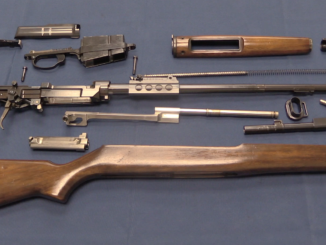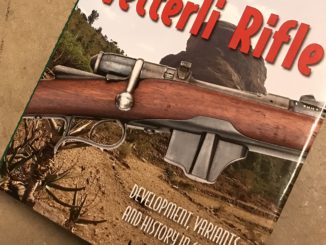Today we are looking at two examples of prewar/wartime Beretta compact pistols. The first is a Tipo Alleggerito Model 34 in .380. This was developed because of a quirk in Italian law which prohibited the civilian sale of military small arms. Beretta had been selling the Model 1934 commercially for a few years before it was adopted by the Italian military, and that adoption turned it into a de facto military weapon, thus prohibiting further commercial sale. Beretta complained to the government, and cited two rather odd arguments for why they should be able to continue selling them. First, the claimed that .380 was a large caliber and thus more suited to close range than long range and thus more of a civilian weapon than a military one. Second, that it was recognized that pistols under 600g (about 21 ounces) were widely acknowledged to be civilian. Following this second argument, they made a small number of lightweight model (“Tipo Alleggerito”) Model 1934s with enough material removed from the barrels to weigh in just under 600g.
The Italian government rejected both arguments, however, and the guns never went into real production.
The second pistol is an aluminum alloy framed version of a Model 1935 in .32ACP. This model was not used by the Italian military, so it was fair game to sell to the civilian market. Beretta made a small number of guns in 1940 and earlier using aluminum frames for a lighter gun, and this is one of them. They did try this on the .380 caliber Model 1934, but found the recoil to be a bit too heavy for long-term durability of the barrel seat. After World War Two, this sort of aluminum frame became common on the compact Beretta pistols sold commercially, but the design was developed before the war.




Sounds like much ado over cosmetic problems. If politicians had better understanding of the subject before they argued about it, lots of time and money would be saved in the long run. But I digress, the company tried to work around the restrictions and found a no-go..,
If politicians would simply recognize the inherent right to self-defense of their citizens, I’d be British. ; )
For a current example of Italian legislative influence, see the NY legal Desert Eagle L5 – just light enough to comply w/ NY pistol law.
The scary thing is, that politicians are about as clueless about any other subject they make laws for. Be it house building regulations, taxes, environment protection, education…
See also:
https://www.forgottenweapons.com/professional-ordnance-carbon-15-a-super-light-awb-ar-15/
“The Professional Ordnance Carbon-15 was developed during the assault weapons ban in the United States as a way to market a pistol version of an AR15 action without exceeding the weight limit imposed by legislation.”
— Ian McCollum
Oh no! All this talk of gun laws will bring the socialist sympathizer out of his cave to scold us!
Anyway, here’s another of Ian’s videos of a firearm designed to circumvent silly laws: https://www.forgottenweapons.com/unintended-consequences-of-the-awb-the-olympic-arms-oa-98/
Socialist? Am I “woke “as well?
Under Musso, there was no legislation that meant anything, because fascism doesn’t use law. Beretta didn’t or couldn’t come up with the bribes various black-shirted mugs demanded, so no deal. I don’t think I’m exaggerating.
Attempts to map modern policy and legislative concerns onto fascism, especially Italian fascism after it had fermented for 16 years, are useless.
Sorry, Ian. I hope your good old site will never decay into political opinionating.
I learned in school in my history class that nazis were hellbent on nation, and fascists were for state, everything was state first. So law certainly was not unimportant, as its basicly a distillate of state
“(…)Musso, there was no legislation that meant anything, because fascism doesn’t use law(…)”
What is source of claim that [Italian] fascism doesn’t use law?
If it so why they bother to introduce Code of Rocco in 1930?
https://scholarlycommons.law.northwestern.edu/cgi/viewcontent.cgi?article=2386&context=jclc
I doubt the law had much to do with the concerns of modern anti-gun activists, and more to do with the government wanting more control over its suppliers.
I wish you could do a review of the beretta m1951. I own one and love it.
..so a military general could be trolling the whole Italian shooting community by formally adopting every civilian firearm ever made 🙂
And then he will get shot in the back!
“Rule Beaters” would make for an interesting collection. I once had one of those 18cm “Austrian legal” pistols, it definitely let me shoot more accurately!
Well, I would call them Rule Adherents, anyway at least 18cm was kept in Czechoslovakia and there were European manufacturers which made automatic pistol compliant with that rule https://unblinkingeye.com/Guns/MABA/maba.html states that
These included Clement, Fabrique Nationale, Steyr, MAB, Nicolas Pieper, and several Spanish manufacturers whose pistols were distributed in Czechoslovakia. The New Model Melior, manufactured by the Belgian firm Robar and Co ., was available with a long barrel, as were the Czech Slavia, Mars, and DUO pistols
For more modern example Saiga-366 https://modernfirearms.net/en/shotguns/tg2-saiga-366/ has Paradox bore to be legally shotgun.
I recently bought a C&Rsenal branded T-shirt; my first for over 3 decades. I will buy a ‘Fireplace Guy’ branded T-shirt of any kind. Suggest Othias’ Ian face and the fireplace we have grown to love.
“Tipo Alleggerito ” means “Lightened Type”, more or less in Italian.
I have a .380 and a .32 with Italian Navy proof markings. Nice little guns.
Interesting that they cut rings aroudn the barrel to lighten it, isntead of just lightening the barrel towards the chamber (imagine something akin the M16 A2 or M4 barrels) and keeping the circumference in the front to support the slide there. Seems like an easier machine work to me compared to cutting lots of rings into the barrel.